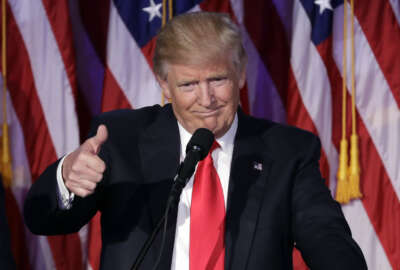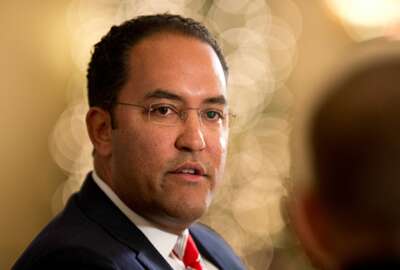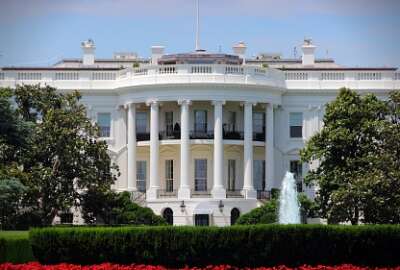

Federal IT experts say it’s unclear what a Trump administration will focus on when it comes to technology policies and programs.
The federal technology community probably is the one part of the public sector that always is confident and calm in the face of any new administration. So as the transition to President-elect Donald Trump kicks into high gear over the next 72 days, federal technology experts say there are three related, but wholly different phases that agencies and companies should pay close attention to.
Phase one started Nov. 9 — now that the election is over, the Obama administration now knows who will replace it and Congress enters the lame duck session.
“Now that there is a date certain for Obama to influence things, I think there will be a rush to action for any final executive branch actions,” said Dave Wennergren, a former Navy chief information officer and deputy CIO for the Defense Department. “I think there will be a flurry of activity, much like what we’ve seen over the last few months as the White House pushed out policies. I also think there will be a rush to spend dollars. Agencies will spend money with teams they know, especially since there is no certainty of what future budgets will look like. I imagine there will be an uptick in spending for rest of the calendar year.”
But Wennergren, who is the executive vice president of operations and technology at the Professional Services Council, said there is a small window on Capitol Hill to get things done. He said beyond another continuing resolution and maybe the Defense Authorization bill, there are concerns that lawmakers get out of town fairly quickly without accomplishing much more than they have to get done to keep the government running.
“We would like the Senate to take action on the Modernizing Government Technology (MGT) bill. I’m not sure if it is more or less likely after the election, but my hunch is less likely,” he said. “With a lame-duck Congress, why should they deal with anything more than you have to? They could pass a CR through March and not come back until the new Congress starts. I’m a little concerned. I do think the MGT bill would help and I’d hate to see a lost effort in the House.”
Trey Hodgkins, the senior vice president for public sector at the IT Alliance for Public Sector (ITAPS), said congressional committees and members interested in technology and acquisition won re-election, particularly Rep. Will Hurd (R-Texas), chairman of the Oversight and Government Reform Subcommittee on IT, and Sen. Ron Johnson (R-Wis.), chairman of the Homeland Security and Governmental Affairs Committee.
“Any legislative initiative faces the threat of the calendar. It’s extremely truncated and there are some things the Republicans may try to advance and the Modernizing Government Technology bill is one of them,” Hodgkins said. “[Legislation] was not allowed to proceed in the Senate before the election because there was a hesitation to advance legislation that could be seen as success for Republicans facing reelection. So those things were delayed not because of value or veracity or substance, but for other reasons. Now that those reasons are gone, I think we will see some of those things make progress.”
Hodgkins said Johnson’s committee may hold a markup to tweak the MGT bill and then hotline it through the Senate to set up a potential conference with the House.
Mike Hettinger, a former House committee staffer and now managing principal of Hettinger Strategy Group, said he doesn’t expect lawmakers to accomplish much during the lame-duck sessions beyond another continuing resolution, but the fact that Hurd, Johnson and other MGT bill supporters were reelected is a good sign that the bill has legs.
Along with the MGT bill, the Defense Authorization legislation is another one the federal IT community is following closely.
Hodgkins said the NDAA could be a path for the IT modernization bill.
“I think the dynamic there has always been about figuring out what Congress can pass and not get vetoed,” he said. “We’ve heard conversations are happening and the bill is moving forward again. I think the NDAA will achieve completion.”
After the lame-duck session, the federal community moves into Phase 2 of the presidential transition where Trump begins nominating secretaries, deputy secretaries and other senior political appointees.
Experts say who the President nominates will set the tone for the first 100 days of the administration.
Since Trump’s policy positions around federal IT are not well known, experts say the first 100 days will begin to show his hand.
“Donald Trump ran on a platform of change, promising to scrutinize the way the government works, and streamline and reduce the size of government. Federal IT modernization, and streamlined procurement of IT services, particularly innovative cloud solutions, is a critical component of the government’s mission, so we are optimistic that this will be a high priority in the Trump administration,” said David LeDuc, senior director for public policy at the Software & Information Industry Association (SIIA). “For instance, SIIA maintains concerns with the lack of oversight and accountability for 18F, and the current implementation of the Federal Risk Authorization and Management Program (FedRAMP) process. These are both areas where we expect President Trump and his technology team will closely scrutinize. We are also optimistic that President Trump will continue the long-standing priority to pursue a ‘buy, not build,’ or COTS-first approach across the federal government.”
But Niam Yaraghi, a Brookings Institution fellow for technology and innovation, said so little is known about Trump’s plans for federal management, let alone technology, the way forward is anyone’s guess.
“One of biggest differences between Obama and Trump is their approach to decision making,” Yaraghi said. “Obama was a guy who really believed in business intelligence and data analysis, and he believed in this approach. He wanted to use data and you need IT to do that, so I would argue Obama knew the importance of these systems. He didn’t look at IT as a line item or as overhead. He looked at IT as a strategic investment. I’m not sure Trump has that mentality.”
An industry source, who requested anonymity, made a similar comparison. The source said it was clear from the campaign that the Obama administration would focus on technology, data and innovation based on what the President did during the election.
“Obama had techie people and was plugged into a technology circle,” the source said. “Trump isn’t a computer guy and not a techie. Most of the people we see him surrounding himself with are likely not that type of person either.”
The source said because Obama focused so much on technology issues, the federal IT footprint grew over the last eight years. During the first 100 days of the Trump administration, the source said, many will be watching how he addresses or focuses on technology initiatives.
The third phase of the transition is the rest of 2017 after the first 100 days.
PSC’s Wennergren said what will be interesting is how the Trump administration continues the IT and cyber initiatives currently in place.
Experts agree that the names of the programs may change, and the focus may be tweaked, but there is little doubt that the President’s executives will stop data center consolidation or IT modernization.
“The Trump campaign is already asking for information about the burdens contractors and businesses [face] more broadly in the public sector market and economy at large,” ITAPS’s Hodgkins said. “I’m sure they will be revisiting some of the executive orders and the executive branch initiatives that have come out. They will look at their value at least as they are currently constructed, and some of those would be changed and others perhaps rescinded.”
Experts agree the executive orders on fair pay and safe workplaces are certainly going to be revisited and likely rescinded. In all, the Obama administration issued 14 executive orders that impacted contractors.
“There are a number that served to bring the federal government to a forward leaning place that the technology sector already is like paid leave for example,” Hodgkins said. “Some of those will not be revisited. But for others there are some underlying questions about many of the initiatives.”
LeDuc said SIIA is urging Trump to focus on data-driven innovation by giving “significant policy-making responsibility in senior positions in the White House.” He said the White House should continue to manage and govern through evidence and data.
One initiative that many experts agree could get new life is outsourcing under Circular A-76.
For much of the past nine years, Congress has prohibited any funding for public-private competitions under A-76.
But the NDAA includes a language to begin revisiting this concept and a Republican administration and Congress also could give it new life.
“Clearly with a Republican administration, it’s less likely for them to push for work to come into government,” Wennergren said. “A Trump administration probably bodes well for the idea of relying on the private sector more, but a counter-balancing force is how much he has said he wants to shrink government spending. That may reduce IT spending no matter who does it.”
Brookings’ Yaraghi said another big area of focus likely will be around the federal procurement process. He said a Trump administration may want to simplify and create more opportunities for small technology firms to compete.
“IT is a stable domain and IT is non-partisan so it’s likely to be business as usual for the time being,” Yaraghi said. “But I have no sense about not only about federal IT but even about larger and more prominent issues like healthcare. I would assume we should expect to see policies aligned with the concepts of driving down costs and increasing competition.”
Read the latest news about the incoming administration on our Tracking the Transition page.
Copyright © 2025 Federal News Network. All rights reserved. This website is not intended for users located within the European Economic Area.
Jason Miller is executive editor of Federal News Network and directs news coverage on the people, policy and programs of the federal government.
Follow @jmillerWFED



